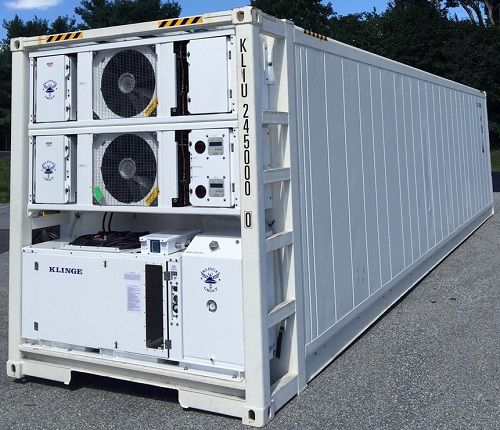Ocean transportation for life sciences: More reliable, more cost-effective
Advanced engineering brings powered, active control of temperature-sensitive shipments via ocean containers
Supply chain managers in life sciences, and their freight-forwarding logistics partners, look endlessly for cost-saving measures to provide more economical transportation. Counterpoised against that driver, however, is the need for high-quality, validated processes for ensuring the safety and efficacy of life-saving biopharma products.
For many years, this challenge has hindered the use of ocean freight for biopharma products transportation; delivery and transit times were too uncertain, among other operational factors. However, vendors of temperature-controlled equipment have responded to this challenge by significantly upgrading the capabilities of storage and transport equipment. Such is the case at Klinge Corporation, a leading provider of highly engineered ocean containers.
Pharmaceutical companies can safely store and transport pharmaceuticals in Dual Refrigerated Containers (active refrigeration system) such as those provided by Klinge Corp. “Klinge Corp’s Dual Refrigerated Containers give pharmaceutical companies peace of mind as the risk of temperature deviations are essentially zero,” says Klinge Corp Sales Manager, Allan Klinge. “The system is comprised of a shipping container with two full-capacity refrigeration systems whereby the refrigeration unit automatically switches to its back-up in case of emergency,” he adds.
The dual refrigerated container for ocean shipping

The use of this ultra-reliable dual refrigeration system is critical when transporting temperature-controlled pharmaceuticals in any market, but particularly in emerging markets that have inadequate infrastructure, wide ranging climates and temperatures, and regulatory obstacles. The increasing shift to growing and emerging markets in BRICM countries (Brazil, Russia, India, China, and Mexico) coupled with the rise of biotech products requiring refrigeration during storage and transport has made the supply chain much more complex. Companies must deal with several security concerns, inadequate transport infrastructure, product integrity, country-specific regulatory obstacles and vastly different temperature ranges and climates.
The majority of biotech products (as well as vaccines and blood products) require cooling between 2°C and 8°C. Klinge Corp’s transport solution for cold chain supplies is especially capable of maintaining the these common temperature requirements as well as offering redundant solutions down to -60°C. All of Klinge’s systems are designed and built to withstand harsh climates and severe atmospheric conditions.
Adding to the fail-safe dual refrigeration system is the integral generator set. The diesel generator set powers the dual refrigeration systems during transport when power is not available, such as during transport on a truck, or in a shipyard. This is particularly important if the shipment is held up due to customs, or extensive road transport. Like the refrigeration systems, the generator set was designed to meet the rigorous demands of ocean, over-the-road, and rail transport.
Global monitoring
Safety and security of pharma products is paramount. Klinge Corp offers GSM and satellite communication systems that communicate cargo temperature, location, alarm status and power source in near real-time. The data is accessible on a password-protected website for each individual customer. Alerts can be emailed and text messaged to the customer’s desired personnel. This technology prevents temperature excursions from occurring as the data is tracked and monitored during storage and transport.
In addition, the Dual Refrigerated Containers can be provided with temperature recorders that display and store temperatures and alarm status. All data is stored with a date/time stamp in a large memory store. Data will not be lost if power supply is disconnected. For temperatures above -30°C, the temperature recorders are also available with a printer for quick printing.
“The superior reliability of the Dual Refrigerated Container is supplemented by the system’s back-up power supply, satellite monitoring system, and temperature recorder. These features allow cold chain supplies to be transported by ocean and provides companies with control over their supply chain at a significantly lower cost than air transport,” says Allan Klinge.
“The first priority with shipping life sciences products is always to ensure their safety,” adds Klinge. “But when that safety can be ensured, and transportation costs cut by a factor of five or more, it’s a win-win solution for life sciences shippers. Add to that the supply chain flexibility of transporting these containers from ports of entry to end destinations—all with satellite tracking and continuous monitoring in place—and you have a more reliable option for life sciences companies.”
For more information on the Dual Refrigerated Container specifically, click here.
CASE STUDY: The Antarctic challenge
An example of Klinge’s superior performance can be found in a completed scientific project in the Antarctic. The US National Science Foundation purchased Klinge Corp’s Dual Refrigerated Container System through Raytheon Polar Services Company, to store and transport ice core samples from Antarctica to the United States. Valued at millions of dollars per container (three containers total), the ice core samples were kept at their required temperature in Klinge Corp’s Dual Refrigerated Containers from McMurdo Station in the South Pole, across the equator, and to the National Ice Core Laboratory in Denver, Colorado.
“Given the monetary and scientific value of the ice core samples, it was absolutely critical that Klinge Corp safely store and transport the temperature-sensitive goods,” says Jason Flynn, Engineering Manager at Klinge Corporation. “Additionally, our Dual Refrigerated Containers have been used by leading chemical and pharmaceutical companies for the last 30 years.”